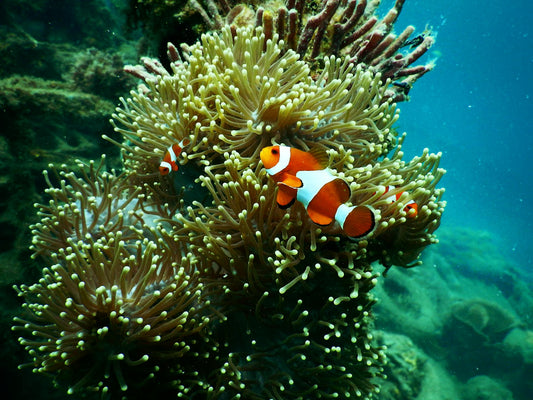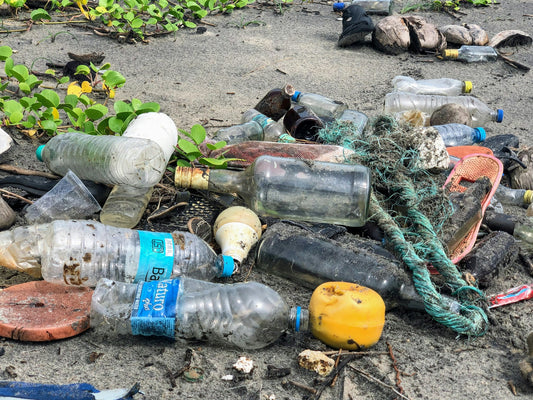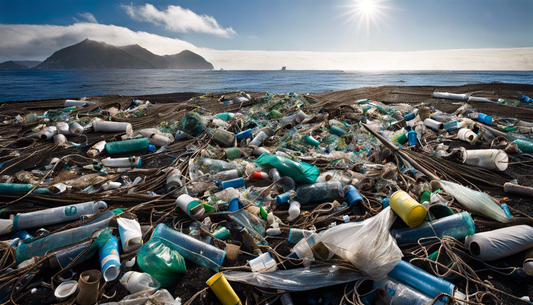Share
Plastic Pollution is on the Rise

Our planet desperately needs effective measures to tackle plastic pollution. We could fill a whole article with scary statistics about plastic pollution and its consequences – millions of animals die from plastic every year, 56% of marine mammals have consumed plastic, and it is estimated that by 2050 there will be more plastic in the ocean than fish.
But listing statistics is not the purpose of this article. Rather, we want to understand how we could get to this point and how we can move the needle into the right direction. We will recap the history of plastic and how the plastic industry misled the public into celebrating plastic recycling as the solution to a problem they created.
Plastic has become an integral part of our daily lives and with the increasing awareness of the impact of plastic waste on the environment, the issue of recycling has again gained significant attention. Recycling is often promoted as a silver bullet to solving the plastic waste crisis. Only if we understand the complex history of plastic and recycling, we can work towards a better future and prevent history from repeating itself.
So how did we get here in the first place?
A brief history of plastic

Trust me, while this might seem like a history lesson, it is truly fascinating and relevant how plastic flooded our lives in only a few decades after its invention.
The beginning of the plastic industry is often dated back to Alexander Parkes, an English Scientist, who in 1855 treated natural cellulose with acid and discovered the formation of a new material. While Parkes tried to market his invention as a method for waterproofing and coating materials, his company needed to file for bankruptcy only years after its formation.
In the 1860s, the American chemist John Wesley Hyatt picked up Parkes’ research, motivated by a $10k reward (today more than $200k) offered by Billard ball manufacturer Phelan & Collander. Billard balls back then were manufactured from Ivory and the rising popularity of Billiards led to scarcity and rising prices. After all, there were only so many elephants to be slaughtered.
In 1870, Hyatt reached a breakthrough that should change the world forever. He discovered celluloid, a “plastic” that could be produced in multiple shapes, was durable and had the ability to replace natural materials in products that had traditionally been made from tortoise shell, rhino horn, ivory, or even wood and stone. For the first time in history, production was not bound to the limitations of natural resources.
Hyatt’s invention was not only good for the economy, but it also helped significantly reduce poaching and was celebrated as the savior for elephants and tortoises. Because of plastics, humans would finally be able to live in harmony with nature and would not need to pillage natural resources.
Celluloid only had one problem. It was not suitable for mass production and thus could not meet the demand for its many adaptations. That changed, when Leo Baekeland created Bakelite in 1907, the first entirely synthetic plastic with no naturally occurring molecules. Bakelite was made to replace shellac, a natural insulator, to meet the demands of America's rapid electrification. It was a strong insulator, durable, heat-resistant, and perfect for mechanical mass production.
What followed were almost six decades of soaring demand and new inventions. The successes of celluloid and Bakelite motivated big oil and chemical companies to invest in research and develop new forms of plastic for different applications.

The biggest surge happened during World War Two. Plastic production soared an incredible 300%, as the war required rapid expansion of production to supply alternatives for naturally produced materials. Nylon, invented 1935, replaced cotton and silk as it was used in helmets, body armor, and parachutes. Plexiglas on the other hand was a great replacement for regular glass and was used in vehicles and planes.
The rise of the plastic industry continued post war. More and more natural products were replaced with plastic. Plastic replaced paper and glass as packaging, wood in toys and furniture, and step by step plastic found its way into every angle of life.
It was only in the 1960 when the public perception of the new material started to shift. Concerns grew over the environmental impact of plastic waste. Increasingly, plastic was seen as a symbol of a disposable, throwaway culture that was contributing to pollution and harming wildlife.
The Introduction of Recycling

The big plastic producers found themselves on a tipping point. Stock prices began to decline, revenues were shrinking, and more and more protests were targeted against them. In response to this negative public perception, the plastic industry began to promote the idea of plastic recycling. Producers touted the benefits of recycling, arguing that it would help reduce waste and conserve natural resources. The industry also created a variety of recycling symbols and labels to make it easier for consumers to identify and recycle different types of plastics.
Over decades the big plastic producers invested millions in marketing campaigns that promoted recycling as a solution to the plastic problem and shifted the responsibility to the consumer.
However, the claims made by the industry were exaggerated and misleading. For example, some companies claimed that almost all plastic products are recyclable, but willingly ignored the fact that only certain types of plastic can be recycled efficiently due to degrading quality. Additionally, the industry often downplayed the challenges associated with recycling, such as the cost and difficulty of processing, sorting, and cleaning materials, which still poses a challenge 60 years later.
As a result, consumers are confused and still overestimate the efficacy of recycling today. A study finds that 94% of Americans support recycling and 74% say it should be a priority. The sad reality is that only 9% of plastic waste is recycled globally and even less (4-5%) in the US. Is that the consumer’s fault? Hardly so!
After decades of misinformation and strategic greenwashing campaigns, consumers have been distracted into thinking they do not need to worry about their plastic consumption and recycling will solve the problem. Until a few years ago, I personally threw every plastic item that had a recycling symbol into the blue bin, thinking I’m doing something good for nature.
Consequently, the plastic industry is thriving like never before. Since 1950, the yearly global plastic production increased faster than any other material. It grew 230-fold from 2 million tons to 400 million tons today and we are nowhere near a slowdown.
If we continue like this, we are driving our planet against a solid wall at full speed! The good news is you CAN make an impact with small everyday life choices.
Consumers Against Plastic Pollution

Reduce your plastic consumption: Your single most powerful leverage as a consumer is your purchasing power. By reducing your plastic consumption and choosing products that come in sustainable packaging, you can send a powerful message to corporations and pressure them to become more sustainable. This can be achieved by choosing to purchase products that have minimal or no packaging, bringing reusable bags to the grocery store, using a refillable water bottle, and bringing your own containers for takeout food. By taking small steps to reduce your plastic consumption, you can help reduce the demand for single-use plastics. Pro tip: Many supermarkets have products in more sustainable packaging at no extra cost. If you have a choice, take the products packed in paper (68% recycling rate in the U.S.), aluminum (50% recycling rate in the U.S.), or glass (31% recycling rate in the U.S.). The three materials have significantly higher recycling rates than plastic both globally and in North America. Glass and aluminum can also be recycled endlessly without losing quality. You can also find many sustainable companies that offer great alternatives for everyday products like toothpaste or deodorant traditionally packaged in plastic.
Educate yourself about plastic and the actual effectiveness of recycling:
By reading this article, you are already on the right path. Knowing the impact of plastic on our planet and what can and cannot be recycled is important to reduce plastic pollution. Be skeptical when you come across content or initiatives that are overly optimistic about plastic usage and recycling. If you look for the sponsor, you will often find lobby organizations by the plastic industry sponsoring this type of content. Look at this brand new initiative for example that paints plastic as a sustainable material critical for our planet’s future. If you look closer, you'll notice that the campaign is funded by the Chemistry Industry Association of Canada, the leading representation of Canada's plastic industry.
We find ourselves in a situation that is not very different from the 1960s when people became increasingly negative about plastic pollution. Pressured by carbon regulations, the big plastic producing oil companies will invest heavily into campaigns to promote plastic and recycling as key to a sustainable future. Always be aware that while increasing the recycling rates for plastic is important, recycling is the last resort after reducing upstream plastic production in the first place.
Furthermore, try to educate yourself on your local recycling program to ensure that you are recycling properly. Often you can also find special programs for specific products by producers or communities.
Avoid hard-to-recycle plastics: If you must purchase plastic products or packaging for lack of alternatives, it's important to avoid hard-to-recycle plastics. These include items such as plastic bags, plastic utensils, and polystyrene foam. Go for products made from more easily recycled plastics, such as PET or HDPE. As a rule of thumb, you can remember “the higher the code, the harder to recycle”. Below illustration gives you a breakdown of all recycling codes, their common uses, and Recycling rates*. You'll mostly find these codes on the bottom or side of packages.

Support businesses and NGOs that fight plastic pollution: There are many NGOs that are dedicated to fighting plastic pollution and supporting them can help make a difference. Consider donating to organizations such as The Ocean Cleanup or Plastic Pollution Coalition, which work to reduce plastic pollution and raise awareness about the issue.
If you want to make an impact with your own hands, most organizations are looking for volunteers to help with organization or participate in cleanups and other events. Not only are you making a tangible difference, but you can also meet fun people and could find yourself a new hobby.
Demand innovation from businesses and regulators: Lastly, your voice can change a lot. Businesses and regulators have the biggest lever to reduce plastic pollution. By demanding innovation in packaging and waste management, individuals can encourage these entities to take a more proactive approach to reducing plastic pollution. This can include supporting companies that prioritize sustainability and putting pressure on regulators. An easy way to do this is by signing online petitions. NGOs like the Plastic Pollution Coalition, change.org or ipetitions.com often list plastic-related petitions. From increasing the number of recycling bins in your city to raising your voice for UN regulations, you will surely find something for you. All it takes it 2 minutes of your time to make a meaningful impact.
If you want to even do more, you can join peaceful protests around you. A quick google search will reveal upcoming events around your hometown.
Lastly, if elections are around the corner, check out the candidate program and vote for the candidate with the most sustainable and innovative policy plans. Regulators have a great responsibility to use their legislative power to reduce pollution.
Conclusion: Reycling Cannot be the Silver Bullet
In conclusion, while recycling is an important part of the solution to the plastic waste crisis, it is not a silver bullet. The history of plastic and recycling reveals that the plastic industry has played a significant role in promoting recycling as a means of deflecting attention from the real problem: the overproduction of plastic.
To truly address the plastic waste crisis, we need to reduce our reliance on plastic, invest in alternative materials, and hold the plastic industry accountable for its role in creating the problem. By understanding the complex and controversial history of plastic and recycling, we can move towards more effective and sustainable solutions for a healthier planet.
We hope you enjoyed this article. If you want to read more like this, make sure to check out our Blog and follow us on Instagram. If you are interested in more sustainable eco SWOPs, check out our Shop.








